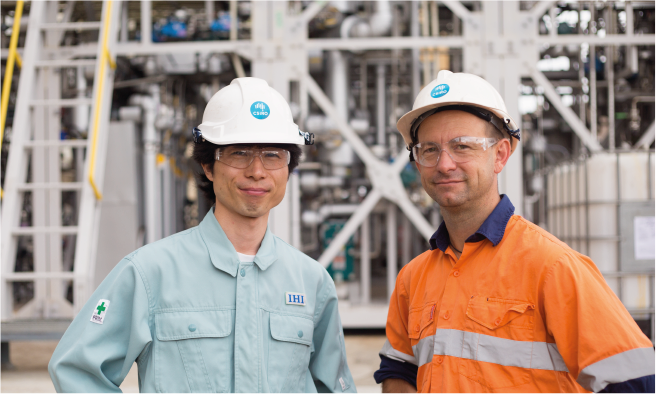Developing industrial science and technology
We have been collaborating with National Institute of Advanced Industrial Science and Technology (AIST) since the organisation's formation in 2001, and have a number of collaborative and staff exchange activities.
In 2016, our Manufacturing team and AIST Advanced Coating started collaborating on the use of novel metal oxide layers in flexible electronics. A Collaborative Research Agreement was signed between the two groups and in 2019, the proceedings of the project were presented in an international conference.

In 2018, visiting researchers from AIST upgraded the sky camera installation which had been tested at CSIRO for the past year. The unit is to be further tested before installation at the Pinnacles Desert calibration site, located approximately 200 kilometres north of Perth, Australia. It will be used by national organisations like Geoscience Australia and international organisations that rely on spaceborne imagery.
We have also worked with AIST in the areas of:
- energy: clean coal, energy storage, PV and thermal solar energy
- metal membranes/inorganic films
- CO2 geological capture and storage/geothermal power generation
- standard generalised markup language (GeoSci ML)
- calibration of satellite data
- flexible electronics.
Researching oceanic climates
We have been a member of the Japan Agency for Marine-Earth Science and Technology (JAMSTEC) Advisory Board since 2012.
For the last 10 years CSIRO Oceans and Atmosphere has collaborated with the Meteorological Research Institute and the National Research Institute for Earth Science and Disaster Prevention on regional climate model inter-comparisons.
The team is working closely with the Japan Meteorological Agency (JMA), JAMSTEC and Tohoku University on the international Argo project which builds, maintains and monitors a large network of autonomous buoys that provide a constant stream of essential information on the globe's oceans.
We are working with researchers from JMA and JAMSTEC on the development of ocean forecasting capabilities under an international initiative called the Global Ocean Data Assimilation Experiment (GODAE) OceanView. GODAE OceanView has run for over 10 years and has established operational ocean forecasting capabilities at many international agencies, including Australia’s Bureau of Meteorology.

Gasifying brown coal
CSIRO is working with Japan's Kawasaki Heavy Industries on a hydrogen energy supply chain (HESC) project in the Latrobe Valley.
The project includes a pilot plant to gasify brown coal and produce hydrogen for export to Japan in liquefied form. The pilot plant is located near a well-characterised carbon dioxide storage reservoir in the Gippsland Basin.
Evaluating post-combustion carbon dioxide capture system

In 2014, we started collaborating with the IHI Coporation and Australia's AGL Energy on a project to evaluate IHI's and CSIRO’s advanced post-combustion carbon dioxide capture (PCC) process systems in the Victorian brown coal-fired power stations.
The new IHI PCC plant has captured CO2 in the flue gas from AGL Loy Yang, Australia since December 2015. In 2018, the partners began assessing a project involving the use of carbon dioxide for horticulture.
Developing industrial science and technology
We have been collaborating with National Institute of Advanced Industrial Science and Technology (AIST) since the organisation's formation in 2001, and have a number of collaborative and staff exchange activities.
In 2016, our Manufacturing team and AIST Advanced Coating started collaborating on the use of novel metal oxide layers in flexible electronics. A Collaborative Research Agreement was signed between the two groups and in 2019, the proceedings of the project were presented in an international conference.
In 2018, visiting researchers from AIST upgraded the sky camera installation which had been tested at CSIRO for the past year. The unit is to be further tested before installation at the Pinnacles Desert calibration site, located approximately 200 kilometres north of Perth, Australia. It will be used by national organisations like Geoscience Australia and international organisations that rely on spaceborne imagery.
We have also worked with AIST in the areas of:
- energy: clean coal, energy storage, PV and thermal solar energy
- metal membranes/inorganic films
- CO2 geological capture and storage/geothermal power generation
- standard generalised markup language (GeoSci ML)
- calibration of satellite data
- flexible electronics.
Researching oceanic climates
We have been a member of the Japan Agency for Marine-Earth Science and Technology (JAMSTEC) Advisory Board since 2012.
For the last 10 years CSIRO Oceans and Atmosphere has collaborated with the Meteorological Research Institute and the National Research Institute for Earth Science and Disaster Prevention on regional climate model inter-comparisons.
The team is working closely with the Japan Meteorological Agency (JMA), JAMSTEC and Tohoku University on the international Argo project which builds, maintains and monitors a large network of autonomous buoys that provide a constant stream of essential information on the globe's oceans.
We are working with researchers from JMA and JAMSTEC on the development of ocean forecasting capabilities under an international initiative called the Global Ocean Data Assimilation Experiment (GODAE) OceanView. GODAE OceanView has run for over 10 years and has established operational ocean forecasting capabilities at many international agencies, including Australia’s Bureau of Meteorology.
Gasifying brown coal
CSIRO is working with Japan's Kawasaki Heavy Industries on a hydrogen energy supply chain (HESC) project in the Latrobe Valley.
The project includes a pilot plant to gasify brown coal and produce hydrogen for export to Japan in liquefied form. The pilot plant is located near a well-characterised carbon dioxide storage reservoir in the Gippsland Basin.
Evaluating post-combustion carbon dioxide capture system
In 2014, we started collaborating with the IHI Coporation and Australia's AGL Energy on a project to evaluate IHI's and CSIRO’s advanced post-combustion carbon dioxide capture (PCC) process systems in the Victorian brown coal-fired power stations.
The new IHI PCC plant has captured CO2 in the flue gas from AGL Loy Yang, Australia since December 2015. In 2018, the partners began assessing a project involving the use of carbon dioxide for horticulture.


